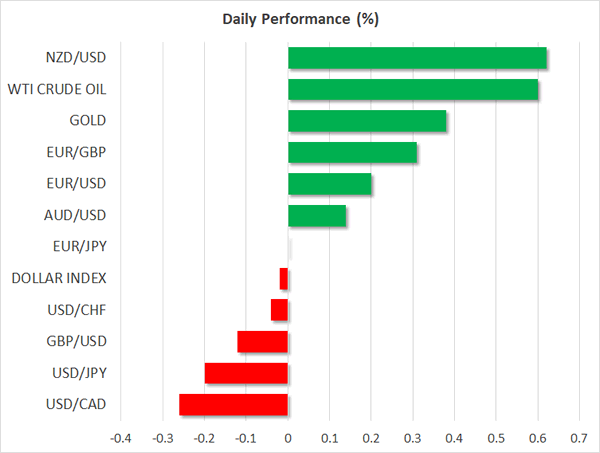Here are the latest developments in global markets:
FOREX: The dollar continued to trade near yesterday’s lows versus its major peers as tax risks kept weighing on the currency after another US Senate Republican warned to give a "no-vote" on the promised tax cuts. Dollar/yen was weaker at 112.18 (-0.18%). Euro/dollar posted moderate gains, rising marginally above the 1.1800 key-level (+0.20%) as yesterday’s dovish ECB signals on eurozone’s inflation restricted larger gains. The pound was steady at $1.3418, while the kiwi remained the best performer, jumping to a fresh two-month high of $0.7032 (+0.64%) after New Zealand’s finance minister expressed his confidence on the currency’s trend. Dollar/loonie stood at 1.2751 (-0.34%).
STOCKS: An unexpected drop in H&M sales – one of the world’s biggest fast-fashion retailers – drove the European stocks lower despite a rise in utilities, while losses in tech shares continued to weigh on European indices as well. The benchmark STOXX 600 and the blue-chip STOXX 50 was down by 0.33% at 1030 GMT. The German DAX 30 fell by 0.38% and the French CAC 40 retreated by 0.33%. The British FTSE 100 was flat.
COMMODITIES: Oil prices inched up during early European trading hours, supported by the ongoing supply restrictions in the North Sea but fears over rising US output remained a drag in the market. WTI crude was last up by 0.75% on the day at $57.47 per barrel and Brent strengthened by 0.24% to $63.46. Gold rose by 0.40% to $1,257.70 per ounce.

Day ahead: EU leaders meet to discuss Brexit; US & Canada release industrial figures
EU leaders are said to officially approve the UK PM May’s divorce proposals today at the end of the two-day EU summit in Brussels and therefore move negotiations to the next stage of future relations. Still, the media stated that May accepted on Thursday the EU offer to postpone the long-desired trade talks until March, giving room for discussions on the transition period, as the UK still has to clarify the sort of trade deal it wants to achieve. Note that May, whose hand is weaker now as she suffered a defeat over her Brexit plans in the British Parliament on Wednesday, will not attend Friday’s meeting.
Meanwhile in the US, the cloud around the future of tax legislation becomes darker as Republicans who reached a joint agreement on tax plans with their House counterparts on Wednesday, continue to lack support from their inner cycle. With Florida’s Senator Republican, Marco Rubio, threatening on Thursday to oppose the proposed tax cuts, the bill could face a cliff-edge as Republicans cannot afford to lose more than two-votes without Democrats’ support. Today, Republicans are anticipated to unveil the final bill before the crucial vote early next week.
Looking at today’s economic calendar, the US and Canada will report figures on industrial trends.
The New York Fed will publish readings on New York’s manufacturing conditions for the month of December at 1330 GMT. Forecasts suggest the index to decline by 0.8 points to 18.60.
At 1415 GMT growth in industrial production reported by the Fed is forecasted to slow down to 0.3% m/m in December after reaching a six-month high of 0.9% in the previous month.
In Canada, manufacturing sales will be available at 1330 GMT with analysts projecting the measure to increase by 0.3 percentage points to 0.8% m/m in October.
In energy markets, investors will keep a close eye on the US oil rig count issued by the Baker Hughes company at 1800 GMT. Potential increases in active drilling rigs would add further losses to oil prices which recently have been under pressure as concerns over rising output in the US weighed on the market.














